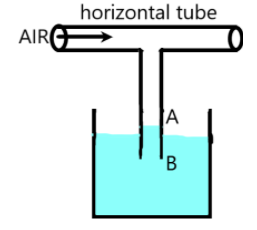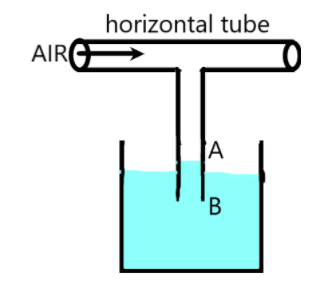
Water stands at level A in the arrangement shown in the figure. If a jet of air is gently blown into the horizontal tube in the direction shown, then

A) Water will fall below A in the capillary tube.
B) Water will rise above A in the capillary tube.
C) There will be no effect on the level of water in the capillary tube.
D) Air will emerge from end B in the form of bubbles.

Answer
558.6k+ views
Hint: We need to understand the relation between the air pressure and the liquid column in the tube to solve this problem. The relation between the speed of the air and the pressure change caused by it also has to be taken into consideration for the same.
Complete answer:
We are given a situation in which a capillary tube with a horizontal tube attached to it as shown in the figure.

We know that the capillary rise in the tube by the liquid is the work done by the liquid against the atmospheric pressure. If P is the atmospheric pressure, then the pressure exerted by the liquid column of height ‘h’ is given as –
\[P=h\rho g\]
Now, according to Bernoulli's principle, a fluid with a greater speed tends to create a low-pressure area. The speed of the fluid and the pressure are inversely proportional to each other.
Let us consider the situation in our problem in which air is blown into the horizontal tube. As the air is blown, the air attains a speed greater than the initial condition resulting in the lowering of the pressure inside the tube. So, now a low-pressure area is created inside the tube.
The pressure exerted by the liquid column will not change with any pressure change in the air. The liquid continues to exert the same pressure P, but the opposing pressure is lower now, as a result the liquid column moves up from the level A to a height h’ which is greater than h.
Therefore, the liquid level rises above the point A.
The correct answer is option B.
Note:
The height attained by a liquid in a capillary tube is the work done against the air pressure above the liquid. This effect is called the Venturi effect. As the pressure decreases, the height of the liquid column increases in the capillary tube as in the present case.
Complete answer:
We are given a situation in which a capillary tube with a horizontal tube attached to it as shown in the figure.

We know that the capillary rise in the tube by the liquid is the work done by the liquid against the atmospheric pressure. If P is the atmospheric pressure, then the pressure exerted by the liquid column of height ‘h’ is given as –
\[P=h\rho g\]
Now, according to Bernoulli's principle, a fluid with a greater speed tends to create a low-pressure area. The speed of the fluid and the pressure are inversely proportional to each other.
Let us consider the situation in our problem in which air is blown into the horizontal tube. As the air is blown, the air attains a speed greater than the initial condition resulting in the lowering of the pressure inside the tube. So, now a low-pressure area is created inside the tube.
The pressure exerted by the liquid column will not change with any pressure change in the air. The liquid continues to exert the same pressure P, but the opposing pressure is lower now, as a result the liquid column moves up from the level A to a height h’ which is greater than h.
Therefore, the liquid level rises above the point A.
The correct answer is option B.
Note:
The height attained by a liquid in a capillary tube is the work done against the air pressure above the liquid. This effect is called the Venturi effect. As the pressure decreases, the height of the liquid column increases in the capillary tube as in the present case.
Recently Updated Pages
Master Class 11 Business Studies: Engaging Questions & Answers for Success

Master Class 11 Computer Science: Engaging Questions & Answers for Success

Master Class 11 Maths: Engaging Questions & Answers for Success

Master Class 11 Chemistry: Engaging Questions & Answers for Success

Master Class 11 Economics: Engaging Questions & Answers for Success

Master Class 11 Accountancy: Engaging Questions & Answers for Success

Trending doubts
What is meant by exothermic and endothermic reactions class 11 chemistry CBSE

10 examples of friction in our daily life

One Metric ton is equal to kg A 10000 B 1000 C 100 class 11 physics CBSE

1 Quintal is equal to a 110 kg b 10 kg c 100kg d 1000 class 11 physics CBSE

Difference Between Prokaryotic Cells and Eukaryotic Cells

What are Quantum numbers Explain the quantum number class 11 chemistry CBSE




